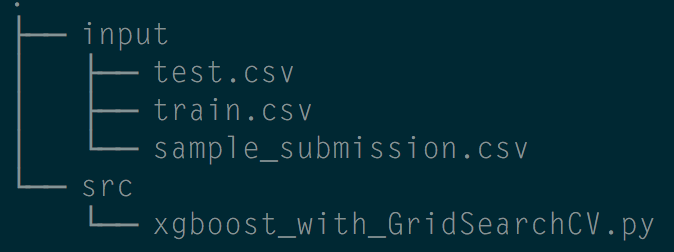1、官网下载kaggle数据集Homesite Competition数据集,文件结构大致如下:

2、代码实战
#Parameter grid search with xgboost #feature engineering is not so useful and the LB is so overfitted/underfitted #so it is good to trust your CV #go xgboost, go mxnet, go DMLC! http://dmlc.ml #Credit to Shize's R code and the python re-implementation import pandas as pd import numpy as np import xgboost as xgb from sklearn import preprocessing from sklearn.cross_validation import train_test_split from sklearn.cross_validation import * from sklearn.grid_search import GridSearchCV train = pd.read_csv("input/train.csv")[:1000] test = pd.read_csv("input/test.csv")[:100] #去掉无意义的feature train = train.drop('QuoteNumber', axis=1) test = test.drop('QuoteNumber', axis=1) # Lets play with some dates #转换feature到更有物理含义的格式 train['Date'] = pd.to_datetime(pd.Series(train['Original_Quote_Date'])) train = train.drop('Original_Quote_Date', axis=1) test['Date'] = pd.to_datetime(pd.Series(test['Original_Quote_Date'])) test = test.drop('Original_Quote_Date', axis=1) #如果我们将 datetime 转为年月日,则为物理含义更好的 feature: train['Year'] = train['Date'].apply(lambda x: int(str(x)[:4])) train['Month'] = train['Date'].apply(lambda x: int(str(x)[5:7])) train['weekday'] = train['Date'].dt.dayofweek # test['Year'] = test['Date'].apply(lambda x: int(str(x)[:4])) test['Month'] = test['Date'].apply(lambda x: int(str(x)[5:7])) test['weekday'] = test['Date'].dt.dayofweek train = train.drop('Date', axis=1) test = test.drop('Date', axis=1) #fill -999 to NAs #这里先简单处理一下,把所有缺失值填上一个不太可能出现的取值: train = train.fillna(-999) test = test.fillna(-999) features = list(train.columns[1:]) #la colonne 0 est le quote_conversionflag print(features) #对类别性质的feature做LabelEncode #现实数据中很多特征并不是数值类型,而是类别类型, #比如红色/蓝色/白色之类,虽然决策树天然擅长处理类别类型的特征, #但是还是需要我们把原始的字符串值转为类别编号。 for f in train.columns: if train[f].dtype=='object': print(f) lbl = preprocessing.LabelEncoder() # lbl.fit(list(train[f].values)) lbl.fit(list(train[f].values) + list(test[f].values)) train[f] = lbl.transform(list(train[f].values)) test[f] = lbl.transform(list(test[f].values)) xgb_model = xgb.XGBClassifier() #brute force scan for all parameters, here are the tricks #usually max_depth is 6,7,8 #learning rate is around 0.05, but small changes may make big diff #tuning min_child_weight subsample colsample_bytree can have #much fun of fighting against overfit #n_estimators is how many round of boosting #finally, ensemble xgboost with multiple seeds may reduce variance parameters = {'nthread':[4], #when use hyperthread, xgboost may become slower 'objective':['binary:logistic'], 'learning_rate': [0.05], #so called `eta` value 'max_depth': [6], 'min_child_weight': [11], 'silent': [1], 'subsample': [0.8], 'colsample_bytree': [0.7], 'n_estimators': [5], #number of trees, change it to 1000 for better results 'missing':[-999], 'seed': [1337]} #使用 CV (cross validation) 做 xgb 分类器模型的调参 clf = GridSearchCV(xgb_model, parameters, n_jobs=5, cv=StratifiedKFold(train['QuoteConversion_Flag'], n_folds=5, shuffle=True), scoring='roc_auc', verbose=2, refit=True) clf.fit(train[features], train["QuoteConversion_Flag"]) #trust your CV! best_parameters, score, _ = max(clf.grid_scores_, key=lambda x: x[1]) print('Raw AUC score:', score) for param_name in sorted(best_parameters.keys()): print("%s: %r" % (param_name, best_parameters[param_name])) test_probs = clf.predict_proba(test[features])[:,1] sample = pd.read_csv('input/sample_submission.csv') sample.QuoteConversion_Flag = test_probs sample.to_csv("xgboost_best_parameter_submission.csv", index=False)